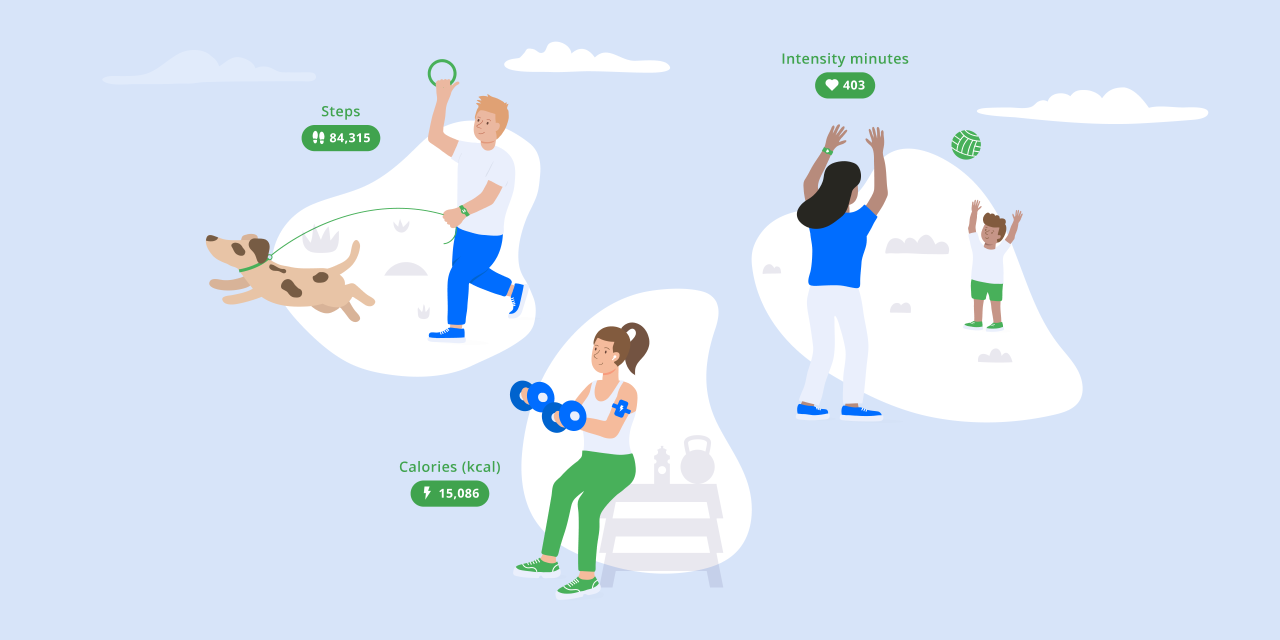
Physical Activity Level Calculator
1. Activity Calculator
Table of Contents
2. What Is YuMuuv Activity Index?
It is a calculation based on physical activity that:
- combines the average of various parameters related to physical activity (steps taken, intensity minutes collected with a moderately high heart rate, calories burned)
- takes into account a person's individual characteristics (age, sex, height, weight), regardless of his or her physical ability
- creates a harmonized activity assessment scale (for recommended thresholds, between colleagues and across companies) for comparison of activity numbers
3. What Parameters Does the Activity Index Take Into Account and Why?
3.1. Steps
Measuring steps is one of the most common and simplified ways to assess physical activity. After the 1964 Tokyo Olympics, 10,000 steps a day "as a Manpo-kei challenge" quickly became popular, and its impact continues to this day.1 On the one hand, it was originally a marketing initiative rather than a scientific one, but on the other hand, later research shows that it also has a clear substantive background.
Recent research has shown that people who take nearly 12,000 steps a day are many times less likely to die earlier than those who take only 4,000 steps a day.2 Based on this, YuMuuv has formulated the 100% step goal in exactly 12,000 steps - exceeding it today has no clearly researched and scientifically justified benefits for those who exactly meet this goal.
However, it is important to mention that every step is worth taking, and up to the goal limit, it can be reasonably said that it also creates better preconditions for a healthy life. Technically, it is possible to use a telephone to measure the steps, but much more detailed information can be obtained from the wrist via the activity monitor / sports watch (there are even more accurate, but not widely used devices). However, even such a method is not perfectly accurate, measuring rather hand movement, but it is still the best available tool today to assess physical activity and measure its effectiveness through movement.
3.2. Intensity minutes
Although, exercise is important by nature, not every form of exercise can ensure a healthy load on our heart, but above all, training that provides it is the most beneficial to health, according to research. The World Health Organization has stated that it is recommended that every adult of working age do at least 150 minutes of moderate-intensity aerobic exercise or 75 minutes of high-intensity aerobic exercise per week.3
It is best to collect these minutes at least 10 at a time (for example, 30 minutes 5 times a week). More broadly, deriving activity from heart rate data is one of the most accurate ways available to humans today. Almost all brands of high-quality watch / monitor manufacturers are now equipped with 24/7 heart rate measurement capabilities, which becomes even more accurate as technology advances.
With this in mind, YuMuuv uses the intense minute target of 100% for one day of 20 minutes, which is done with a 65% or above of maximum heart rate.4 This threshold is calculated based on the estimated maximum human heart rate, which has a calculated formula of 206.9 - (0.67 x age).5
3.3. Kilocalories
The third parameter in YuMuuv is the kilocalories consumed. It also helps to include in the activity measurement activities that do not involve many steps or a significant increase in heart rate, but still involve physical activity. More broadly, calories are the most common indicator of physical activity, based first on individual basal metabolic rate (BMR) and then on physical activity level (PAL).
The goal of calories burned in YuMuuv is 1.55 x BMR. In other words, if, for example, a person's estimated basal metabolism (which in turn depends on physiological parameters) is 1500kcal, then the target for kilocalories would be 2325kcal per day. There are various analyzes of what constitutes an adequate active human basal metabolic rate, but the common formula uses a multiplier of PAL 1.55 for 100%.6
4. Physiological Characteristics and Functional Limits?
The YuMuuv formula is clearly built to find out who is active, but not necessarily the one who is very athletically capable (although they may be related). In essence, in the YuMuuv formula, everyone is on an equal footing, regardless of their training or physiological parameters. In summary, every activity counts, not a specific sport, so people are not directed to any specific activity, but to physical activity more broadly.
5. What Are the Activity Levels?
* assumptions are valid only if the person wears a device that measures all 3 parameters on a daily basis
100%+ = exemplary active – a person who enjoys and values an active lifestyle very much and is thus maximizing the health benefits associated with adequate exercise.
85-99% = actively mobile – a person for whom a mobile lifestyle is an important value and who receives part of the positive effects of activity.
70-84% = sufficiently active – a person whose level of activity is sufficient to experience the benefits of exercise to a certain extent, and who at the same time has the opportunity to increase its positive effect by increasing activity.
55-69% = moderately active – a person who has moderate physical activity and who has the opportunity to see significantly more health-improving results by increasing activity.
40-54% = low activity – a person to whom physical activity is rather a secondary area of life, as a result of which the positive impact on quality of life resulting from sufficient exercise is not implemented.
25-39% = dangerously passive – a person who has either a good reason for temporary inactivity or who has high health risks due to low activity.
- https://www.health.harvard.edu/blog/10000-steps-a-day-or-fewer-2019071117305
- https://jamanetwork.com/journals/jama/article-abstract/2763292
- https://www.ncbi.nlm.nih.gov/pmc/articles/PMC6536904/
- https://pubmed.ncbi.nlm.nih.gov/17468581/
- https://www.verywellfit.com/maximum-heart-rate-1231221
- https://www.ncbi.nlm.nih.gov/pmc/articles/PMC3636460/
